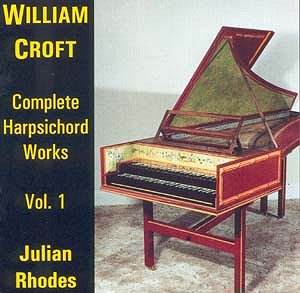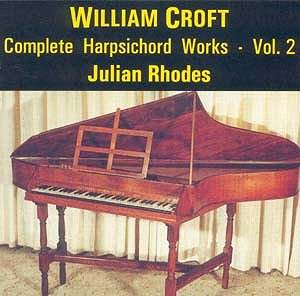| WILLIAM CROFT (1678-1727) Complete Harpsichord Works Volume 1 [76.57] Suite no. 1 in C major Chaconne in A minor Suite no. 15 in A major Suite no. 12 in F major Saraband in F major Suite no. 7 in E flat major Suite no. 11 in E minor Suite no. 5 in C minor Suite no. 15 in A major Suite no. 13 in G major Suite no. 4 in C minor Suite no. 10 in E minor Trumpet Overture in D Volume 2 ** [78.51] Suite no. 16 in A major Suite no. 9 in E minor Suite no. 14 in G minor Suite in C major/minor Suite no. 19 in F minor Suite no. 18 in D minor Suite no. 3 in C minor Suite in G major/minor Suite no. 8 in E major Suite no. 17 in B minor Suite no. 6 in D minor Suite in D major Rec: April 1999, Highampton, Devon, England. |
  |
Crotchet AmazonUK AmazonUS Amazon recommendations |
|
Occasionally, one comes across individuals with a mission. This is the case with J. Martin Stafford. He has managed to save several rare, yet essential recordings from oblivion. These include the clavichord and organ recordings of Thurston Dart. He also recently oversaw the recording of William Croft's Complete Harpsichord Works on 2 discs, by Julian Rhodes.
William Croft was born in Nether Ettington, near Stratford-upon-Avon, in England. As a child, he sang under John Blow in the Chapel Royal, and, in 1708, succeeded Blow as organist at Westminster Abbey. While not a famous composer, at least not in posterity, he wrote sacred music for the church and incidental music for four plays performed at Drury Lane Theatre, as well as more than 70 anthems.
Little of Croft's keyboard music was published during his lifetime. Most of it was unavailable until 1974, when Howard Ferguson and Christopher Hogwood published a two-volume edition of it. (Two additional suites were added to this corpus in an expanded edition of 1982.) Needless to say, Croft's keyboard music was more or less forgotten.
These two discs contain all of Croft's music for harpsichord, played on three instruments: virginal, spinet and harpsichord. The late Julian Rhodes (unfortunately, this excellent young keyboard player died recently) plays these works with great delicacy and grace, ornamenting with great discretion. These are not virtuoso works, but rather very melodic pieces, with simple, yet effective song-like melodies. Rhodes gives an excellent performance here, neither overplaying the pieces nor being too shy - his interpretation is clearly his own, yet he lets the music take the forefront
Most of these works are suites, ranging from two to five movements, the longest just under 11 minutes long. There are also several isolated pieces, which Rhodes organised in "synthetic" suites, and a few other short pieces that stand alone.
Suite no. 15 in A major is a fine example of Croft's style. With a simple melody in the first movement, an Almand, he goes on to develop this melody in the other movements, a Courant, Air and Saraband. In Croft's suites there is a very strong melodic similarity among the different movements, making them more like variations. Croft has a unique way, similar to Haendel, of taking very simple melodies and making highly enjoyable music - he makes a lot out of very little.
The Chaconne in A minor is a delightful piece. A chaconne is a sort of variation piece, where a simple theme is presented and restated several times, with elaborations and variations. This short work is melodically reminiscent of the theme in Buxtehude's Aria "La Capricciosa", with a simple, almost dainty melody. Croft takes this and weaves a beautiful series of brief variations around it, ranging from simple chords to long, sinuous melodic runs.
The Trumpet Overture in D is an interesting piece. This is an arrangement, probably by Croft himself, of two works he submitted for his doctorate at Oxford University. The opening Overture is regal and imposing, and, indeed, one can hear the trumpets in the work's strong chords. The second movement, an Allegro, is a much lighter version of the overture, covering a similar harmonic structure. The third movement, Adagio, is, again, essentially a chordal piece, but this time with more ornamentation, making it less imposing than the overture. This movement, in a minor key, has a serious, almost ominous sound to it. The final Allegro recalls some of Purcell's harpsichord works, and, through a delightful combination of rhythmic chords and melodic runs, closes the piece energetically, with that unmistakable sound of English music.
Some of these works are very lively and energetic, such as Suite no. 16, which is flamboyant and flashy, full of bright, showy effects. Others are more solemn, such as the Suite no. 9, which, in E minor, presents all the tone colours of this minor key. Here the music is plaintive and very French in tone, similar to some of the melodies of Louis Couperin.
The choice of instruments used on this recording is very interesting, and does justice to the music. The pieces played on the more intimate virginal and spinet have a more 'homey' sound, such as the "synthetic" Suite in C major/minor, which is basically a grouping of several movements, played on the spinet, or the similar-sounding Suite in C major/minor. These instruments sound exquisite, and the recording is excellent as well.
These little-known works by a forgotten English composer are miniature masterpieces that deserve to be rediscovered. These two discs are excellently performed and recorded, and belong in the music library of all those who like English music or harpsichord music in general. Let William Croft no longer be forgotten.
Kirk McElhearn
CONTACT DETAILS
http://ourworld-top.cs.com/ismeron99/index.html